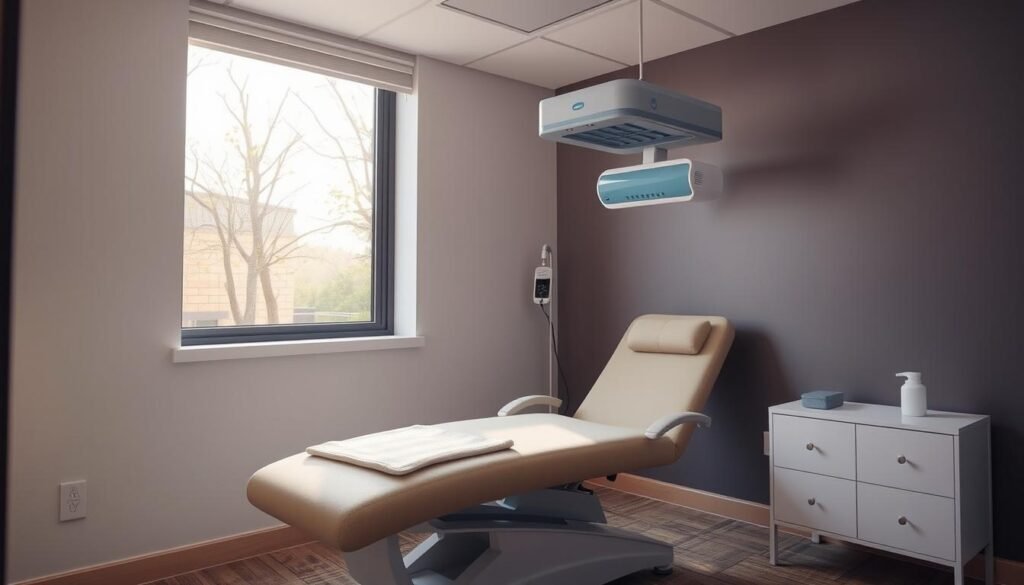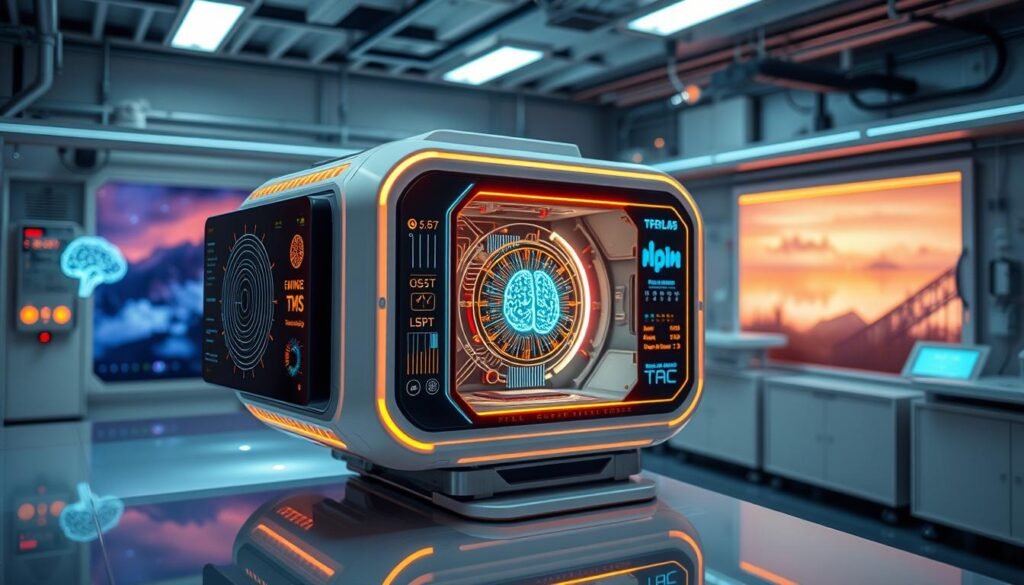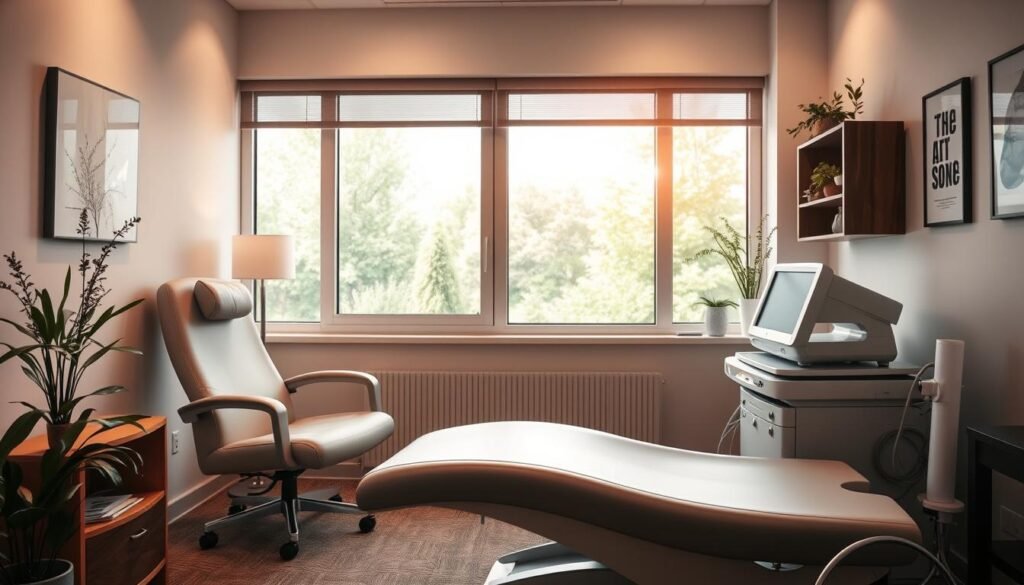Have you thought about a non-invasive way to fight treatment-resistant depression? Transcranial Magnetic Stimulation (TMS) brings hope to those who haven’t had success with medications or therapy. Approved by the FDA in 2008, TMS uses magnets to target brain cells. This boosts mood regulation for people with major depressive disorder.
This piece explores how TMS works, its benefits, and what to expect during treatment. It also looks at how TMS fits into a bigger plan for battling depression. Studies show TMS is twice as effective as traditional remedies for some. If other treatments haven’t helped, TMS might be the solution you’re looking for.
Key Takeaways
- TMS is recognized as a highly effective non-drug treatment for major depressive disorder.
- Approximately one-third to one-half of patients become symptom-free following TMS therapy.
- Most individuals begin to feel improvements after 10 to 15 treatment sessions.
- TMS has a favorable safety profile, with minimal side effects like headaches.
- The treatment typically involves around 30 sessions conducted over several weeks.
Understanding Transcranial Magnetic Stimulation (TMS)
Transcranial magnetic stimulation is a cutting-edge therapy for mental health. It’s especially helpful for those fighting depression. By using magnetic fields, it activates nerve cells in mood-related brain areas. An electromagnetic coil on the scalp releases magnetic pulses, boosting brain activity.
TMS is often suggested for patients who haven’t improved with regular medications. It’s crucial for those with depression that’s hard to treat. Its success in reducing symptoms makes it an attractive alternative to traditional methods.
Research shows TMS works for many people, including those with bipolar disorder. It helps lessen depressive symptoms for patients who didn’t benefit from standard antidepressants. TMS is a major leap forward in treating mental health issues.
How TMS Works for Treating Depression
Transcranial magnetic stimulation (TMS) is a way to treat depression without surgery. It uses magnetic pulses. These pulses start small electrical currents in the brain’s specific areas. It mainly boosts the prefrontal cortex’s activities. This part often works less in depressed people.
Studies show TMS helps 50% to 55% of people feel better. About 30% to 35% fully recover from depression symptoms. TMS therapy usually has around 36 sessions. Each lasts from 20 minutes to an hour. People often get much better during this time.
Patients see big improvements in their moods with TMS. The Montgomery-Asberg Depression Rating Scale confirms this. These good results make TMS a strong choice. It works much better than fake treatments. TMS got the FDA’s okay for depression in 2008. It’s also used for OCD and chronic pain.
Most people handle TMS well, but some might get headaches or feel tingling on their scalp. Severe side effects, like seizures, are very rare. Two-thirds of patients improve noticeably. For 70%, these improvements last up to a year.
TMS’s success prompts more research to make it better. Scientists are looking at ways to shorten treatments or do them more often. TMS is becoming more vital in treating depression. It’s helping reshape how we help those with mood disorders.
For additional information on TMS, you can visit this resource.
Benefits of TMS for Depression
Transcranial Magnetic Stimulation (TMS) offers major benefits for people fighting depression. It’s an FDA-okayed treatment that doesn’t require surgery. It can deeply improve many people’s symptoms.
Non-Invasive and Drug-Free Therapy
TMS doesn’t have the bad side effects that pills for depression often do. You won’t have to deal with upset stomachs or being super tired. The treatment takes just 20-30 minutes. People can get back to their day right after.
Effective for Treatment-Resistant Depression
TMS works well for those who haven’t gotten better with other treatments. About one-third get completely better after six weeks. Plus, if you have more sessions, up to 60% of people see symptom reductions. For those who tried TMS before and got better, doing it again works 80% of the time.
Minimal Side Effects Compared to Traditional Medications
TMS causes fewer side effects than many drugs. A few might feel a bit of discomfort or headaches, but these don’t last long. This makes TMS a good choice for people wanting to avoid the tough side effects of standard treatments.
| Aspect | TMS | Traditional Antidepressants |
|---|---|---|
| Invasiveness | Non-invasive | Invasive (oral/injection) |
| Medication | Drug-free | Medication required |
| Common Side Effects | Mild (scalp discomfort, headache) | Severe (nausea, drowsiness) |
| Symptom Improvement Rate | 50-60% after treatment | 30-64% with medications |
| Time to Improvement | 6 weeks for remission | Varies, often longer |
TMS for Depression: What to Expect During Treatment
If you’re thinking about TMS for depression, it starts by understanding your needs. A detailed assessment is the first step. This includes checking your health history and finding the best spots on your scalp for therapy. This prep work is key to the success of TMS.
Initial Assessment and Mapping Process
The process begins with a talk about your symptoms and past treatments. This lets the doctor understand your battle with depression. Then, a mapping stage identifies the exact brain areas for treatment. This precise targeting is vital for the therapy’s success.
Typical Treatment Session Structure
After the assessment, treatments usually last 20 to 37 minutes. They are done five days a week for several weeks. During sessions, patients feel a tapping sensation and hear clicking sounds. Yet, they stay awake and alert, with no anesthesia needed.

For those facing tough depression, TMS therapy is a hopeful choice. Knowing what to expect makes the experience better.
Who Can Benefit from TMS?
Transcranial Magnetic Stimulation (TMS) offers hope for those fighting depression. It’s especially for those not helped by other treatments. TMS is for adults with major depressive disorder who saw no change with two types of antidepressants or psychotherapy.
Ideal Candidates for TMS Therapy
People with treatment-resistant depression look for other options when usual treatments don’t work. Ideal TMS therapy candidates include:
- Adults diagnosed with major depressive disorder.
- Those who didn’t improve after trying several antidepressants.
- Individuals who didn’t get better with psychotherapy.
- Patients looking for a non-invasive and FDA-approved depression treatment.
Contraindications for TMS Treatment
Though TMS has many benefits, there are important contraindications. They ensure the safety of each patient. Conditions that might stop someone from getting TMS are:
- A history of seizures, which could increase risk.
- Metal implants in the skull, which affect the magnetic fields.
- Active substance abuse or psychotic disorders, which might worsen treatment results.
A deep evaluation by a doctor is key to see if TMS is right. This check makes sure TMS fits the patient’s specific needs. This is vital for those looking to beat depression.
Exploring Treatment Courses and Duration
TMS therapy for depression involves a series of sessions to help patients. The treatment usually lasts four to six weeks. Patients go to sessions five times a week for the best results. This method helps people slowly get better, especially if other treatments haven’t worked.
Length of Treatment Sessions
A TMS session lasts about 20 to 30 minutes. Patients receive magnetic pulses that help improve their mood during this time. There are also faster TMS options that take only two to three weeks. One new method, Theta Burst Stimulation (TBS), uses quick bursts of pulses for better results.
Potential Outcomes and Timeline for Improvement
People often start feeling better after 1 to 2 weeks of treatment. Studies show that 50-60% of those who didn’t improve with medication benefit from TMS. About a third of patients might not feel depressed after treatment. The benefits of TMS can last for more than a year, changing lives.
For more info on long-term low mood and how to manage it, check this link.
| Protocols | Treatment Duration | Description |
|---|---|---|
| Standard Protocol | 4 to 6 weeks | Daily sessions (5 times per week) typically lasting 20-30 minutes. |
| Accelerated Protocol | 2 to 3 weeks | Condensed treatment for patients requiring quicker relief. |
| Theta Burst Stimulation (TBS) | Varies | Delivers high-frequency magnetic pulses in short bursts. |
| Deep TMS | 4 to 6 weeks | Targets deeper brain structures linked to mood regulation. |
Maintaining Depression Relief After TMS
Keeping the gains from TMS treatment requires a good plan. Patients often continue with standard treatments to keep their mental health stable. Mixing different therapy types helps keep depression away and supports full recovery.
Following Up with Conventional Treatments
People usually stick with meds or talking therapies after their TMS ends. These common, approved treatments boost TMS results and lower the chance of getting sick again. About 30% of patients might get depressed again, showing the need for ongoing support.
Potential for Maintenance Sessions
Maintenance TMS has shown promise in keeping the initial benefits going. Studies found that maintenance TMS can notably cut down on the risk of depression returning. Many who get regular maintenance feel better for six months to a year or more. Slowing down the pace of TMS sessions can help avoid new depression episodes, letting people take control of their mental health.
| Maintenance Therapy Frequency | Expected Outcomes | Average Time to Relapse |
|---|---|---|
| Weekly for 6 months | Lower relapse rates | Extended periods of relief |
| Monthly sessions after initial course | Improved stability | Delayed symptoms recurrence |
| Gradual session reduction | Effective management | Preventing future episodes |
Future Research and Advances in TMS Therapy
The transcranial magnetic stimulation (TMS) field is quickly growing. It shows a lot of promise for mental health care’s future. TMS has proven to be a strong option without using drugs for depression. It is also being looked into for other health issues. The goal is to improve TMS and make it useful for more conditions.
Exploring New Conditions for Treatment
Experts are researching TMS for other issues beyond depression. They are focusing on obsessive-compulsive disorder and anxiety disorders. For major depression, many adults see their symptoms lessen or go away thanks to TMS. With approval for more conditions, TMS could help even more people.
Improvements in TMS Technology
There are big changes happening with TMS technology. In 2021, a new kind of TMS, called accelerated TMS, was introduced. It helped 11 out of 14 patients get better in four weeks. New techniques and types of TMS are being developed. They aim to make TMS work better and help patients more.

| Study/Protocol | Condition Treated | Results Achieved | Year |
|---|---|---|---|
| TMS for Depression | Major Depressive Disorder | 66% see remission or reduction | Prior to 2008 |
| Accelerated TMS Protocol | Major Depressive Disorder | 11 out of 14 achieved remission | 2021 |
| TMS Cleared for OCD | Obsessive-Compulsive Disorder | Regulatory clearance | 2018 |
| TMS for Smoking Cessation | Tobacco Addiction | Regulatory clearance | 2020 |
New advancements in TMS are exciting. They promise to make TMS more useful and effective. This could really change how we treat mental health issues.
Risks and Side Effects of TMS
Transcranial Magnetic Stimulation (TMS) therapy is a big step forward in treating depression through brain stimulation. It is important to know the risks and side effects. TMS is generally safer than older treatments like electroconvulsive therapy, especially for depression.
Common and Uncommon Side Effects
Those who get TMS might face different side effects. Knowing them helps make a smart choice about this FDA-approved depression treatment.
- Headaches: About 47% of patients report headaches, making it a common side effect.
- Scalp discomfort: Around 25% feel irritation on their scalp during treatment.
- Muscle twitching: This mild effect occurs in 6% of patients.
- Anxiety: Found in 5% of people treated, anxiety tends to lessen over time.
- Insomnia: Seen in 7% of patients, it’s also noted in placebo groups.
- Serious adverse events: Very rare, under 1% experience them. Seizures are included.
Safety Profile of TMS Treatment
The safety data for TMS looks good, often persuading doctors to pick it as a main way to fight depression. It doesn’t cause big weight gain, sexual problems, or memory loss like some older treatments. Though a few might feel discomfort, it usually goes away fast.
| Side Effect | Percentage of Patients |
|---|---|
| Headaches | 47% |
| Scalp Pain | 25% |
| Muscle Twitching | 6% |
| Anxiety | 5% |
| Insomnia | 7% |
| Serious Adverse Events |
The Role of TMS in a Comprehensive Treatment Plan
Transcranial Magnetic Stimulation (TMS) therapy is crucial for treating major depressive disorder. It’s especially useful for those who don’t find success with traditional treatments. TMS, combined with medication and psychotherapy, offers a well-rounded approach. This strategy meets each patient’s unique mental health needs.
Integrating TMS with Medication and Psychotherapy
Adding TMS to depression treatment boosts the effectiveness. It’s a game-changer for patients who haven’t benefited from standard therapies. The non-invasive nature of TMS, alongside other treatments, targets symptoms more fully. It allows for care that’s tailored to each person.
Potential for Customized Treatment Approaches
Depression affects everyone differently, influencing how they respond to treatment. Adding TMS lets healthcare providers create personalized plans. These plans meet the emotional and physical needs of the individual. It offers a chance for deeper relief and a better recovery path.
Support resources, like online group therapy, enhance the recovery journey. For those looking into deeper insights on managing depression, check out this guide.

Debunking Myths about TMS Therapy
Brain stimulation therapy, or TMS therapy, is a top choice for effective and FDA-approved depression treatment. There are many myths about its safety, effectiveness, and how it’s used. These myths can make people unsure about trying it. It’s important to clear up these wrong ideas for anyone thinking about this treatment.
Misinformation and Misconceptions
Some people think TMS requires staying in the hospital and takes long to recover. But, TMS therapy is done as an outpatient procedure. This means patients can go home right after. Also, it’s a mistake to think TMS only helps with very bad depression. Actually, TMS often works better for those who haven’t been helped by different depression medicines.
The numbers tell a striking story—while only 16% find success with a third medication, around 85% respond well to TMS therapy in many clinics.
Evidence-Based Outcomes from Clinical Studies
Many studies prove TMS therapy is effective and safe, making it a solid choice for hard-to-treat depression. Most people start feeling better within the first few weeks of therapy. A typical treatment plan includes daily sessions, each lasting 15 to 20 minutes, over 4 to 6 weeks. For those in a hurry, Accelerated TMS offers a two-week treatment option.
Since its FDA approval in 2008, TMS therapy is backed by strong scientific evidence. It doesn’t have the widespread side effects many antidepressants do. Making it a better choice for lots of people. To learn more about TMS therapy, check out this in-depth analysis.
Patient Testimonials and Success Stories
Patient testimonials shed light on TMS therapy for depression. They share their journeys of mood improvement and life quality enhancement. Many note big wins, like feeling more motivated and better social involvement.
Real-Life Experiences of TMS Patients
Stories from TMS patients speak of hope and a fresh start. One saw a 60% drop in depression and anxiety. Another felt more vibrant, meeting goals once seen as out of reach. They thank the caring clinical staff, highlighting their support during treatment.
Statistics on Efficacy and Patient Satisfaction
Data backs TMS therapy’s success. Feedback shows a 4.93 average rating from 686 reviews, proving high satisfaction. Over 80% noted their life quality improved post-treatment. Plus, 68% kept their mental health gains for a year. This info suggests TMS is an effective choice for many, especially those battling chronic symptoms. For more insights, see these patient experiences.
| Key Outcomes | Patient Experiences |
|---|---|
| Average Rating | 4.93 based on 686 reviews |
| Improvement in Symptoms | 60% decrease in depression and anxiety |
| Quality of Life Enhancement | Over 80% reported significant improvement |
| Sustained Positive Outcomes | 68% maintained improvements for 12 months |
| Reduction in Medication Usage | Some patients cut depression medication dosage by over 70% |
Conclusion
TMS stands as a major step forward in treating mental health, especially for those dealing with treatment-resistant depression. This FDA-approved method offers new hope. It uses a non-invasive way to stimulate the brain, with a success rate of 70% to 80%. People not helped by usual antidepressants find relief in TMS, making it an important addition to mental health care.
About half of the patients who try TMS get completely better, showing no symptoms at all. This is a big deal when compared to the 27.5% success rate of common antidepressants. Many have tried different medications for months without success, highlighting TMS as a crucial alternative. It seems to work best for those under 60 and those who are naturally more resilient.
In short, Transcranial Magnetic Stimulation marks meaningful progress in psychiatric treatment. It works well alongside medication and therapy, leading to better results. As more research is done, TMS’ ability to change lives points to a bright future in mental health care.